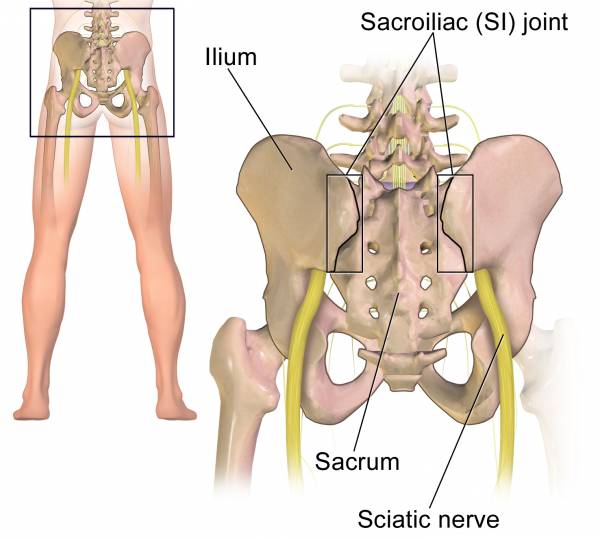Sacroiliac Joint Pain Treatment
Your Sacroiliac Joints are a critical linkage system between your lower spine and pelvis. The sacrum connects on the right and left sides of the ilia (pelvic bones) to form your sacroiliac joints.
Your sacroiliac joints should be a fairly stiff or rigid link between the pelvic bones, and allow only a few degrees of movement.
In some people due to trauma or just extra mobility, your sacroiliac joints have too much uncontrolled motion. This allows your sacroiliac joints to adopt an abnormal or stressed joint position, which may result in SIJ pain.
When your sacroiliac joints are not moving normally due to either stiffness or excessive movement, it is referred to as Sacroiliac Joint Dysfunction, which normally results in sacroiliac pain.
It is vital that you have both normal SIJ movement and muscle control around this area to avoid SIJ pain and injury.
Commonly sacroiliac dysfunction can cause lower back, hip, buttock and sciatic pain.
What Causes Sacroiliac Joint Pain?
There are two main groups of sacroiliac dysfunction that cause SIJ pain:
Hypermobility / Instability - the most common
Hypomobility / Stiffness - normally associated with pathologies such as Ankylosing Spondlyitis
What Causes Sacroiliac Joint Hypermobility?
Your sacroiliac joints should move a few degrees for normal movement. Like most joints, your surrounding muscles act to stabilize your sacroiliac joints during stressful or vulnerable positions.
The most important sacroiliac stabilizing muscles are your deep abdominal core muscles and your deep gluteal muscle groups.
When these muscle groups are weak or lack endurance your sacroiliac joints are vulnerable to excessive movement, which can lead to SIJ hypermobility dysfunction or instability and subsequent sacroiliac joint pain.
What are the Symptoms of Sacroiliac Joint Dysfunction?
Sacroiliac joint dysfunction can mimic numerous other back and hip injuries.
Sacroiliac joint dysfunction can cause lower back, hip, groin, buttock and sciatic pain.
Sacroiliac pain is typically worse with standing and walking and improved when lying down, but not always.
It can sometimes be painful to sit cross legged and is normally painful to lie on your side for extend periods.
Bending forward, stair climbing, hill climbing, and rising from a seated position can also provoke sacroiliac pain.
Sacroiliac pain is sometimes reported to increase during sexual intercourse and menstruation in women.
TREATMENT FOR Sacroiliac Joint PAIN
Chiropractic adjustments - the doctors have a variety of adjusting techniques they can use and will make adjustments to the areas of your sacrum and pelvis that are not functioning correctly that will be comfortable and tailored your comfort level.
Class IV cold laser therapy - laser therapy works to decrease the inflammation and pain associated with SI joint pain, while also accelerating the healing of the damaged tissues.
Myofascial Therapy - your doctor will use a combination of myofascial techniques to reduce trigger points, remove scar tissue adhesions, and release nerve entrapments.
Kinesiotape - this procedure uses specialized tape to support the joints and muscle groups as they heal. When treating low back pain, it is important to keep the joints mobile, while still offering support. The taping methods the doctors use will offer your pelvis support to the muscle groups and allow you to move - as opposed to a bulky brace.
Therapeutic exercises - these exercises are used to stretch and strengthen any associated soft tissues that have become damaged by this condition. Your doctor will tailor your therapeutic exercise program based on the severity of your condition and physical ability.
Dr. Callie Gant and Dr. Michael Buczynski founded Art of Health Chiropractic with the goal of creating a healthier Nashville. Feel free to call the office at 615-953-7544 with any questions or to schedule your first appointment.


